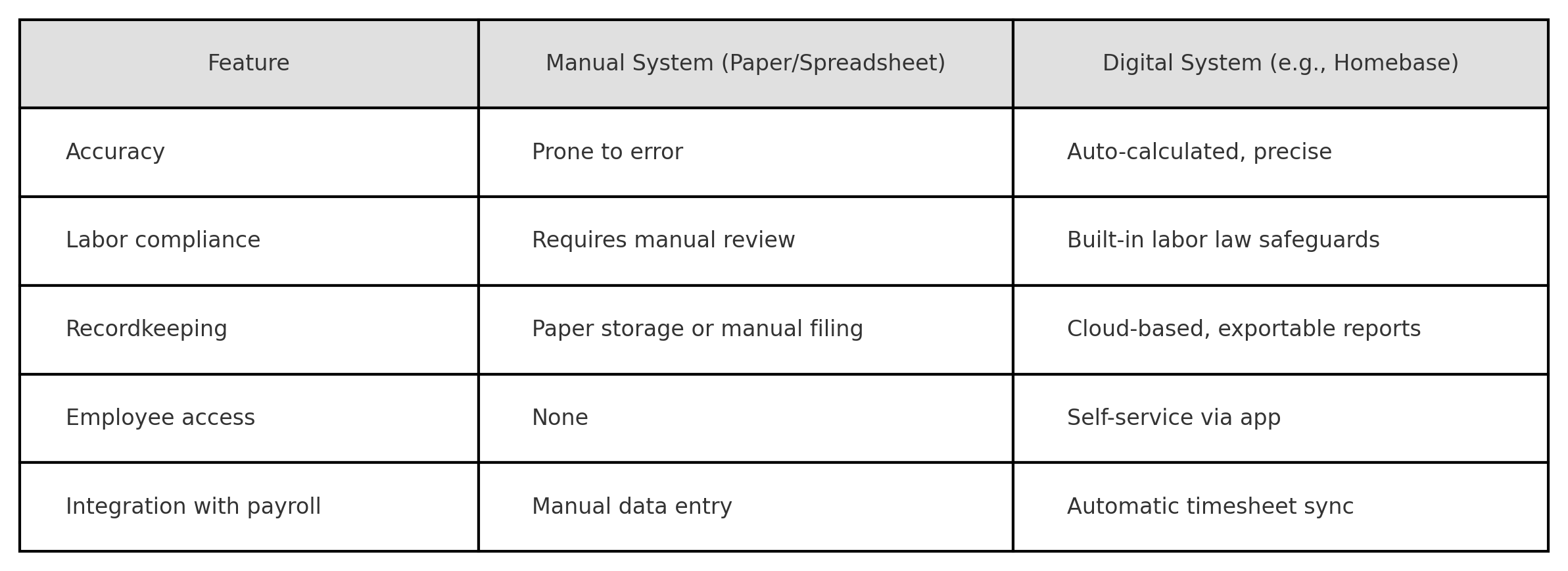What is time and attendance?
Time and attendance refers to the process of tracking when employees start and end their workdays, as well as when they take breaks, clock out for lunch, or call in sick. At its core, it’s about recording employee work hours accurately to ensure proper pay, compliance with labor laws, and effective scheduling.
For small business owners, managing time and attendance manually—through paper timesheets or verbal reporting—can quickly lead to errors, labor disputes, and lost productivity. Digital tools like Homebase help automate time tracking, simplify scheduling, and reduce compliance risks.
What’s included in a time and attendance system?
A time and attendance system may include:
- Clock-in and clock-out tracking (via app, time clock, or kiosk)
- Break and meal tracking
- Paid and unpaid time off requests
- Absence management (e.g., sick days, tardiness)
- Timesheet reporting for payroll
- Shift verification with GPS or geofencing (for mobile workforces)
These systems help ensure employees are paid for the time they actually work, and employers are protected by clear, auditable records.
Why time and attendance tracking matters
Small businesses can’t afford to overlook accurate timekeeping. It plays a critical role in:
1. Payroll accuracy
Incorrect time logs can lead to underpayment, overpayment, or tax mistakes.
2. Labor law compliance
Time tracking ensures you're meeting federal, state, and local requirements around breaks, overtime, and recordkeeping.
3. Employee accountability
Reliable time data helps reduce time theft, buddy punching, and missed shifts.
4. Operational efficiency
Tracking attendance patterns helps you adjust staffing levels based on peak hours or seasonal changes.
5. Team morale and fairness
When schedules and hours are managed fairly and transparently, employees are more likely to trust the process and stay engaged.
Common time and attendance challenges
Without a dedicated system, small businesses often struggle with:
- Inaccurate manual entries
- Lost or incomplete timesheets
- Disputes over hours worked or missed breaks
- Late payroll runs due to missing data
- Compliance issues during audits or inspections
These challenges not only affect your bottom line—they can also open you up to legal and reputational risks.
Paper vs. digital time and attendance systems

Time and attendance laws to know
Employers must comply with federal and state labor laws, including:
- Fair Labor Standards Act (FLSA): Requires accurate tracking of hours worked, minimum wage, and overtime
- Meal and rest break laws: Vary by state and may require specific break timing and tracking
- Recordkeeping laws: Employers must retain time records for at least two years under the FLSA
Some states also have predictive scheduling laws, requiring advance notice of schedules and fair treatment around shift changes.
How Homebase simplifies time and attendance
Homebase offers a free, all-in-one time and attendance system built for hourly and shift-based teams. With Homebase, you can:
- Let employees clock in/out via mobile app, tablet kiosk, or desktop
- Track hours, breaks, and PTO in real time
- Prevent time theft with photo and GPS verification
- Automatically calculate hours and overtime
- Export timesheets directly to payroll
- Monitor labor costs and manage schedules with ease
Explore Homebase Employee Scheduling to streamline your time and attendance processes, improve accuracy, and give your team a simple, transparent way to track every shift.
